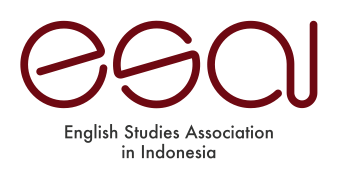EXPLORING GENERATION Z’S METHODS OF LEARNING ENGLISH PRONUNCIATION THROUGH TIKTOK
Abstract
This research explores how Generation Z perceives learning English pronunciation using the social media platform TikTok. Generation Z is known for its familiarity with technology and social media, including TikTok, which is incredibly popular among them. The main objective of this research is to understand how Generation Z perceives and engages with TikTok as a tool for learning English pronunciation, as well as the challenges and opportunities they encounter. The participants in this study were 10th-grade students from SMKN 3 Bojonegoro who were studying PSPT 1 and 2. The research utilized a qualitative approach, combining questionnaire surveys and in-depth interviews to gather comprehensive data on the students' experiences with using TikTok videos to learn English pronunciation. The results revealed that TikTok is a preferred platform for students to practice English, with 58.6% of students feeling comfortable using TikTok for pronunciation practice. Additionally, 63.8% of students stated that TikTok boosted their self-confidence in practicing English pronunciation. The platform offers opportunities for students to practice English in a relaxed, flexible, and engaging manner, thereby increasing motivation. However, the study also identified some challenges and obstacles faced by students, such as being easily distracted by entertainment content, which can lead to a lack of focus, as well as a lack of direct feedback for error correction. In conclusion, this research suggests that TikTok can be an effective tool for Generation Z to learn English pronunciation, as long as engaging and collaborative content is utilized. It is hoped that these findings will contribute to the development of more modern and interactive language learning methods on digital platforms like TikTok.
Keywords
Full Text:
PDFReferences
Addinna, A. (2022). Students’ Perception on the Use of TikTok for Learning English. Journal of English Language Teaching, 11(4), 566–579. https://doi.org/10.24036/jelt.v11i4.119484
Adityo, & Novitasari, L. (2023). Learning English Pronunciation through Social Media Tiktok Account. Education and Human Development Journal, 8(1), 82–92. https://doi.org/10.33086/ehdj.v8i1.4029
Alazemi, F. N. (2021). Effectiveness of Social Media in Education. Volatiles & Essent. Oils, 8(6), 2677–2688.
Astina, Nurhamdah, & Amzah. (2020). THE ANALYSIS OF TEACHING ENGLISH PRONUNCIATION Inspiring : English Education Journal. Inspiring : English Education Journal, 3(1), 1–16.
Baron, R. (2020). Students’ Perception on Online Application in Speaking Skill. VELES Voices of English Language Education Society, 4(2), 213–221. https://doi.org/10.29408/veles.v4i2.2543
Bernard, A. V. (2021). Expanding ESL Students’ Vocabulary Through TikTok Videos. Lensa: Kajian Kebahasaan, Kesusastraan, Dan Budaya, 11(2), 171. https://doi.org/10.26714/lensa.11.2.2021.171-184
Dewi, L. K., & Arifani, Y. (2021). The utilization of line video call and TikTok video for teaching pronunciation in Thailand. Celtic: A Journal of Culture, English Language Teaching, Literature and Linguistics, 8(2), 260–274. https://doi.org/10.22219/celtic.v8i2.18481
Dolot, A. (2018). New trends in management The Characteristics of Generation Z. E-Mentor, 2(2), 44–50.
Ferdian Sari, R., & Wangi, W. (2023). Students’ Perspectives on Using TikTok Videos as a Medium for Learning English. Language and Art Journal, 7(2), 39–56. https://ejournal.unibabwi.ac.id/index.php/lunar/article/download/1458/976
Firamadhina, F. I. R., & Krisnani, H. (2021). PERILAKU GENERASI Z TERHADAP PENGGUNAAN MEDIA SOSIAL TIKTOK: TikTok Sebagai Media Edukasi dan Aktivisme. Share : Social Work Journal, 10(2), 199. https://doi.org/10.24198/share.v10i2.31443
Ginting, D., Fahmi, F., Barella, Y., Hasbi, M., Kadnawi, K., Rojabi, A. R., & Zumrudiana, A. (2022). Students’ perception on TPACK practices on online language classes in the midst of pandemic. International Journal of Evaluation and Research in Education, 11(4), 1995–2009. https://doi.org/10.11591/ijere.v11i4.23014
Hayes, C., Stott, K., Lamb, K. J., & Hurst, G. A. (2020). “Making Every Second Count”: Utilizing TikTok and Systems Thinking to Facilitate Scientific Public Engagement and Contextualization of Chemistry at Home. Journal of Chemical Education, 97(10), 3858–3866. https://doi.org/10.1021/acs.jchemed.0c00511
Herlisya, D., & Wiratno, P. (2022). Having Good Speaking English through Tik Tok Application. Journal Corner of Education, Linguistics, and Literature, 1(3), 191–198. https://doi.org/10.54012/jcell.v1i3.35
Hidalgo, F. J. P. (2019). TELL, CALL, and MALL: Approaches to bridge the language gap. International Approaches to Bridging the Language Gap, January 2020, 118–134. https://doi.org/10.4018/978-1-7998-1219-7.ch008
Lulu Nabila, Heryatun, Y., & Siti Rohbiah, T. (2023). Improving Students’ Pronunciation Using Tongue Twister Technique in TikTok Application. English Education, Linguistics, and Literature Journal, 2(2), 103–116. https://doi.org/10.32678/ell.v2i2.7776
Nasution, D. A. (2023). The Effect of Tiktok Video in Learning Pronunciation Skill at Grade Tenth of SMA Negeri 2 Lubuk Pakam Academic Year 2022 / 2023. 7, 21321–21330.
Nuraeni, C., Carolina, I., Supriyatna, A., Widiati, W., & Bahri, S. (2020). Mobile-Assisted Language Learning (MALL): Students’ Perception and Problems towards Mobile Learning in English Language. Journal of Physics: Conference Series, 1641(1). https://doi.org/10.1088/1742-6596/1641/1/012027
Paz-Domínguez, R. M., Pérez-Noriega, G. P., Hernández-Ángeles, T., & Hidalgo-Avilés, H. (2023). Students’ perceptions towards the use of TikTok as a tool for improving English pronunciation. Revista Lengua y Cultura, 5(9), 97–106. https://doi.org/10.29057/lc.v5i9.11581
Pham, M. T., Nguyen, T. T. Van, & Cao, T. X. T. (2023). Vietnamese Students’ Perceptions of Utilizing Social Media to Enhance English Vocabulary: A Case Study at Van Lang University. In International Journal of TESOL & Education (Vol. 3, Issue 1). https://doi.org/10.54855/ijte.23316
Prabayanti, H. R., Romadoni, Y., & Kusuma, Y. (2022). Media Consumption Patterns to Get English Learning Information in Tiktok. Proceedings of the International Joint Conference on Arts and Humanities 2021 (IJCAH 2021), 618(Ijcah), 857–863. https://doi.org/10.2991/assehr.k.211223.148
Putri, M. K., & Dermawan, R. (2023). Influence of Content Marketing and Influencer Marketing on the Purchase Intention of Somethinc Products on TikTok Gen Z Users in Surabaya. Indonesian Journal of Business Analytics, 3(5), 1663–1672. https://doi.org/10.55927/ijba.v3i5.5437
Rachmawati, D. L., Fadhilawati, D., & Setiawan, S. (2020). The Implementation of Computer-Assisted Language Learning (CALL) in the EFL Setting: A Case Study in a Secondary School in Indonesia. English Teaching Journal: A Journal of English Literature, Linguistics, and Education, 8(2), 91–102. https://doi.org/10.25273/etj.v8i6.7733
Rahmawati, Y., & Anwar, K. (2022). the Use of Tiktok Application: the Impact on Students’ Vocabulary and Attitude. PROJECT (Professional Journal of English Education), 5(Vol 5, No 3 (2022): VOLUME 5 NUMBER 3, MAY 2022), 610–621. https://journal.ikipsiliwangi.ac.id/index.php/project/article/view/10330/pdf
Shabani, K., & Ghasemian, A. (2017). Teacher’s personality type and techniques of teaching pronunciation. Cogent Education, 4(1). https://doi.org/10.1080/2331186X.2017.1313560
Stephenson, M. (2021). The Impact of Technology on Personal Branding and Job Choice. Academy of Management, 51(September), 1–51.
Sugiyono, P. D. (2017). Metode penelitian kuantitatif, kualitatif dan R & D. 25. https://doi.org/9781626239777
Suharti, D. S., Suwandi, E., Zumrudiana, A., Indrasari, N., Lestari, I. W., & Rahayu, N. (2022). Negotiating the dual identities of the student-teacher as both a curriculum technician and a curriculum maker. Electronic Journal of Foreign Language Teaching, 19(1), 206–221. https://doi.org/10.56040/NDSS1927
Suprato, D. (2020). Maximizing social media application for students in learning english. ACM International Conference Proceeding Series. https://doi.org/10.1145/3452144.3452178
Tauchid, A., Zumrudiana, A., & Suwandi, E. (2024). Speaking With Distance : Exploring The Effectiveness of Remote Practice. 5(2). https://doi.org/10.35961/salee.v5i2.1359
Tessalonika Simaremare, J., Veby Ristella Munthe, M., Herman, H., Shaumiwaty, S., Fatmawati, E., Saputra, N., & Tinggi Ilmu Tarbiyah Al-Hilal Sigli, S. (2023). Students’ Perceptions of the Impact of TikTok on Pronunciation: Insights from Indonesia. ISVS E-Journal, 10(11), 437–452. https://doi.org/10.61275/ISVSej-2023-10-11-28
Zainuddin, M., Nahdlatul, U., & Sunan, U. (2023). Implementasi Pembelajaran Bahasa Inggris Menggunakan MALL. 9(1), 1–12.
DOI: http://dx.doi.org/10.30813/jelc.v15i2.6022
Refbacks
- There are currently no refbacks.



2.jpg)



